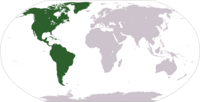British colonization of the Americas
| Part of a series on |
| European colonization of the Americas |
|---|
 |
|
|
British colonization of the Americas (including colonization by both the English and the Scots), began in 1607 in Jamestown, Virginia and reached its peak when colonies had been established throughout the Americas. They were among the three most important colonizers of the Americas, and their American empire came to rival the Spanish American colonies in military and economic might.
Three types of colonies existed in the British Empire in America during the height of its power in the 18th century. These were charter colonies, proprietary colonies and royal colonies. After the end of the Napoleonic Wars (1803–1815), British territories in the Americas were slowly granted more responsible government. In 1838 the Durham Report recommended full responsible government for Canada, but this was not fully implemented for another decade. Eventually, with the Confederation of Canada, the Canadian colonies were granted significant autonomy and became a self-governing Dominion in 1867. Other colonies in the Americas followed at a much slower pace. In this way, two countries in North America, ten in the Caribbean, and one in South America have received their independence from the United Kingdom. All of these are members of the Commonwealth of Nations and nine are Commonwealth realms. The eight remaining British overseas territories in the Americas have varying degrees of self-government.

North America
Pre-British colonization of North America
English colonies in North America

A number of English colonies were established under a system of Proprietary Governors, who were appointed under mercantile charters to English joint stock companies to found and run settlements, most notably the Virginia Company, which created the first successful English settlement at Jamestown and the second at St. George's, Bermuda.
In 1664, England took over the Dutch colony of New Netherland (including the New Amsterdam settlement) which England renamed the Province of New York. With New Netherland, the English also came to control the former New Sweden (in what is now Delaware), which the Dutch had conquered earlier. This later became part of Pennsylvania after that was established in 1680.
Scottish colonies in North America
The Kingdom of Scotland tried unsuccessfully to establish a colony at Darién, and the Scottish colonisation of Nova Scotia (New Scotland) lasted from 1629 to 1632. Thousands of Scotsmen also participated in English colonisation before the two countries were united in 1707.
British colonies in North America
The Kingdom of Great Britain acquired the French colony of Acadia in 1713 and then Canada and the Spanish colony of Florida in 1763. After being renamed the Province of Quebec, the former French Canada was divided into two Provinces, the Canadas, consisting of the old settled country of Lower Canada (today Quebec) and the newly settled Upper Canada (today Ontario).
In the north, the Hudson's Bay Company actively traded for fur with the indigenous peoples, and had competed with French, Aboriginal, and Metis fur traders. The company came to control the entire drainage basin of Hudson Bay, called Rupert's Land. The small part of the Hudson Bay drainage south of the 49th parallel went to the United States in the Anglo-American Convention of 1818.
Thirteen of Great Britain's colonies rebelled in the American Revolutionary War, beginning in 1775, primarily over representation, local laws and tax issues, and established the United States of America, which was recognised internationally with the signing of the Treaty of Paris on 3 September 1783.
Great Britain also colonised the west coast of North America, indirectly via the Hudson's Bay Company licenses west of the Rocky Mountains: the Columbia District and New Caledonia fur district. Most of these were jointly claimed as the Oregon Country by the United States from 1818 until the 49th parallel was established as the international boundary west of the Rockies by the Oregon Treaty of 1846. The Colony of Vancouver Island, founded in 1849, and the Colony of British Columbia, founded in 1858, were combined in 1866 under the name Colony of British Columbia, and joined the Confederation in 1871. British Columbia was expanded with the inclusion of the Stikine Territory in 1863; and upon joining Confederation the Peace River Block, formerly part of Rupert's Land, was added.
In 1867, the colonies of New Brunswick, Nova Scotia, and the Province of Canada (the southern portion of modern-day Ontario and Quebec) combined to form a self-governing dominion, named Canada, within the British Empire (the term "kingdom" was avoided so as to not provoke the United States). Quebec (including what is now the southern portion of Ontario) and Nova Scotia (including what is now New Brunswick and Prince Edward Island) had been ceded to Britain by the French. The colonies of Prince Edward Island and British Columbia joined over the next six years, and Newfoundland joined in 1949. Rupert's Land and the North-Western Territory were ceded to Canada in 1870. This area now consists of the provinces of Manitoba (admitted after negotiation between Canada and a Métis provisional government in 1870), Saskatchewan, and Alberta (both created in 1905), as well as the Northwest Territories, the Yukon Territory (created 1898, following the start of the Klondike Gold Rush), and Nunavut (created in 1999).
List of English and British colonies in North America (in rough chronological order)

- Roanoke Colony, founded 1586, abandoned the next year. Second attempt in 1587 disappeared (also called the Lost Colony).
- Cuttyhunk Island, established as a small fort and trading post by Bartholomew Gosnold in 1602, abandoned after one month.
- Virginia Company, chartered 1606 and became the Virginia Colony in 1624
- London Company
- Jamestown, Virginia, founded 1607 (briefly abandoned in 1610)
- Bermuda, islands located in the North Atlantic, first settled in 1609 by the London Virginia Company; administration passed in 1615 to the Somers Isles Company, formed by the same shareholders. Known officially as the Somers Isles, they remain today a British overseas territory.
- Citie of Henricopolis, founded in 1611 as an alternative to the swampy Jamestown site and was destroyed in the Indian massacre of 1622.
- Plymouth Company
- Popham Colony, founded 1607, abandoned 1608
- London Company
- Society of Merchant Venturers (Newfoundland)
- Cuper's Cove, founded 1610, abandoned in the 1620s
- Bristol's Hope, founded 1618, abandoned in the 1630s
- London and Bristol Company (Newfoundland)
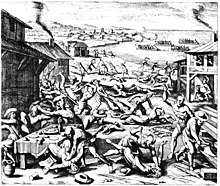
The massacre of Jamestown settlers in 1622. Soon the colonists in the South feared all natives as enemies. - New Cambriol, founded 1617, abandoned before 1637
- Renews, founded 1615, abandoned in 1619[1]
- St. John's, Newfoundland, chartered by Sir Humphrey Gilbert in 1583; seasonal settlements ca. 1520;[2] informal year-round settlers before 1620.[3][4]
- Plymouth Council for New England
- Plymouth Colony, founded 1620, merged with Massachusetts Bay Colony in 1691
- Ferryland, Newfoundland, granted to George Calvert, 1st Baron Baltimore in 1620, first settlers in August 1621[5]
- Province of Maine, granted 1622, sold to Massachusetts Bay Colony in 1677
- South Falkland, Newfoundland, founded 1623 by Henry Cary, 1st Viscount Falkland
- Province of New Hampshire, later New Hampshire settled in 1623, see also New Hampshire Grants
- Dorchester Company Colony, (Dorchester Company planted an unsuccessful fishing colony on Cape Ann at modern Gloucester, Massachusetts in 1624)
- Salem Colony, later Salem, Massachusetts, settled in 1628, merged with Massachusetts Bay Colony the next year
- Massachusetts Bay Colony, later part of Massachusetts, founded 1629
- New Scotland, in present Nova Scotia, 1629–1632
- Connecticut Colony, later part of Connecticut founded 1633
- Province of Maryland, later Maryland, founded in 1634
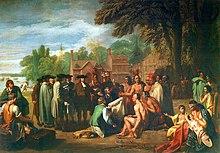
The Treaty of William Penn with the Indians. Penn's Treaty was never violated. - New Albion, chartered in 1634, failed by 1649–50, not to be confused with Nova Albion on the Pacific coast (see next section)
- Saybrook Colony, founded 1635, merged with Connecticut in 1644
- Rhode Island and Providence Plantations, first settled in 1636
- New Haven Colony, founded 1638, merged with Connecticut in 1665
- Gardiners Island, founded 1639, now part of East Hampton, New York
- Province of New York, captured 1664
- Province of New Jersey, captured in 1664
- divided into West Jersey and East Jersey after 1674, each held by its own company of Proprietors.
- Province of Pennsylvania, later Pennsylvania, founded 1681 as an English colony, although first settled by Dutch and Swedes
- Delaware Colony, later Delaware, separated from Pennsylvania in 1704
- Province of Carolina
- Province of North Carolina, first permanent English settlements in late 1600s (nearly a century after the failed Roanoke Colony; see Albemarle Settlements), became separate colony in 1710-12.
- Province of South Carolina, first permanent English settlement in 1670, became separate colony in 1710-12.
- Province of Georgia, later Georgia; first settled in about 1670, formal colony in 1732
- Nova Scotia, site of abortive Scottish colony in 1629; British colony 1713, but this did not permanently include Cape Breton Island until 1758.
- Province of Quebec, which had been called Canada under French rule. Canada was by far the most settled portion of New France. Britain gained complete control of French Canada in 1759–1761, from the events within the North American theater of the Seven Years' War; France ceded title with the Treaty of Paris in 1763. Became Canada East in the Province of Canada, which also included Ontario (Upper Canada) as Canada West, from 1841 to 1867.
- East Florida and West Florida, acquired from Spain in 1763 in exchange for returning Cuba, taken from Spain in 1761; the Floridas were recovered by Spain in 1783. Backwoods areas almost unaffected by the Stamp Act Crisis of 1765, which unified the thirteen colonies that formed the United States, not much for abstract principles, and grateful to the crown, they declined to send representatives to the Continental Congress or to participate in any way in the independence movement. After the Second Spanish period, they were acquired by the United States in 1821.
- Island of St. John, separated from Nova Scotia 1769, renamed Prince Edward Island in 1798
- New Brunswick, separated from Nova Scotia in 1784
- Ontario, separated from Quebec in 1791 as the Province of Upper Canada until 1841, when it became Canada West in the Province of Canada.
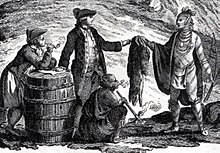
Fur traders in Canada, trading with Indians, 1777 - Province of Canada combined the colonies of Quebec (Lower Canada) and Ontario (Upper Canada) from 1841 to 1867.
- Colony of Vancouver Island, founded by the Hudson's Bay Company at Fort Victoria in 1843. Received royal charter for the Island as a colony in 1849, and merged with the colony of British Columbia in 1866.
- Colony of the Queen Charlotte Islands, founded in 1852, merged with the Colony of Vancouver Island in 1863.
- Colony of British Columbia, also called the Mainland Colony or the Gold Colony, founded in 1858 from the New Caledonia fur district and the remnant of the Columbia fur district north of the 49th parallel (see below). The colony was expanded with the addition of most of the Stikine Territory (also called Stickeen Territory) and the Colony of the Queen Charlotte Islands in 1863.
- Colony of British Columbia, formed in 1866 from a merger of the Vancouver Island and Mainland Colonies. The name British Columbia was chosen for the newly merged colony despite the opposition from Vancouver Island colonists.
Non-colonial British territories in North America
- Rupert's Land, territory of the Hudson's Bay Company, founded in 1670 and transferred to the new Dominion of Canada in 1867 as the Northwest Territories
- Columbia District, the trading district of the Columbia Department of the Hudson's Bay Company from 1821 to the Oregon Treaty of 1846, by which most of the Columbia District was formally annexed to the United States. HBC lands south of the 49th parallel were guaranteed by the Oregon Treaty but ownership and compensation issues were not fully resolved until 1861.
- New Caledonia, fur district. First created in 1805 as part of North West Company for operations, administered by Hudson's Bay Company following the two companies' forced merger in 1821, until incorporated as the part of the Colony of British Columbia in 1858, by which time the term "New Caledonia" had come to refer to the whole of the British Columbia mainland, not just the original fur district in what is now its Central Interior.
- Stikine Territory, also called Stickeen Territories, founded in 1862 in response to the Stikine Gold Rush to prevent an American takeover.
- North-Western Territory, a Hudson's Bay Company trading area covering lands north and northwest of Rupert's Land and, after 1863, north of the Stikine Territory's original boundary at the 62nd parallel. Its remnant was incorporated at the Yukon Territory after the part of it south of the 60th parallel was amalgamated to British Columbia.
- Nova Albion, never incorporated or settled, exact location unknown, claimed by Sir Francis Drake and one of the precedents for the British claims to the Pacific Northwest during the Oregon boundary dispute.
- the southeastern Alaska Panhandle was leased from the Russian Empire, from 1839 to 1867, until the lease was ignored by both the Russians and Americans and, subsequently, by the Canadian and the British imperial governments, despite British Columbia's protests.
Central and South America, Caribbean
English and later British Caribbean colonies

In order of settlement or founding:
- Saint Kitts – The island was settled by Sir Thomas Warner in 1623. The following year the French also settled part of St Kitts. After they massacred the Caribs, the British and French turned on each other and St Kitts changed hands between the two several times before the Treaty of Paris (1783) gave the island to Britain. It became independent as part of Saint Kitts and Nevis in 1983.
- Barbados – The island was claimed for the British Empire in 1625, and later settled in 1627 as a proprietary colony of Anglo-Dutchman William Courten. It became an independent nation in 1966.
- Nevis – The island was permanently settled in 1628. It became independent as part of Saint Kitts and Nevis in 1983.
- Providencia Island – part of an archipelago off the coast of Nicaragua, this island was settled in 1630 by English Puritans. The colony was conquered by the Spanish and became extinct in 1641. The island is today administered by Colombia. Providence Island colony was a sister colony to the more well known Massachusetts Bay Colony.
- Antigua – The island was settled in 1632. It became independent as part of Antigua and Barbuda in 1981.
- Barbuda – The island was settled about 1632. It became independent as part of Antigua and Barbuda in 1981.
- Montserrat – The island was settled in 1632. It was occupied by the French in 1664–68 and 1782–84. It remains a British territory.
- Bahamas – The islands were settled from 1647. They became independent in 1973.
- Anguilla – The island was settled in 1650. Its government was united with St Christopher (St Kitts) from 1882 until 1967, when it declared its separation. It was brought back under British administration in 1969. It remains a British territory.
- Jamaica – The island was conquered from Spain in 1655. It became independent in 1962.
- British Virgin Islands – The islands were settled from 1666. They remain a British territory.
- Cayman Islands – The islands were acquired from Spain in 1670. They remain a British territory.
- Turks and Caicos Islands – The islands were first permanently settled in the 1750s. They remain a British territory.
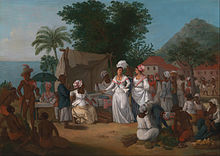
A linen market in the West Indies, circa 1780 - Dominica – The island was captured from the French in 1761. The French occupied it again from 1778 to 1783. Dominica became independent in 1978.
- Trinidad and Tobago – The island of Tobago was captured in 1762. The island of Trinidad was captured from the Spanish in 1797. The two governments were joined in 1888. They became independent in 1962.
- Saint Vincent and the Grenadines – Saint Vincent was colonised in 1762. France captured it in 1779 but returned it to Britain in 1783. The islands were part of the British colony of the British Windward Islands from 1871 to 1958. The nation gained full independence in 1979.
- Grenada – The island was conquered from France in 1762. The French reoccupied it from 1779 to 1783. It became independent in 1974.
- Saint Lucia – The island was captured from the French in 1778, but returned in 1783. In 1796 and in 1803 it was captured again, but permanently annexed by Britain in 1814. Saint Lucia became independent in 1979.
English and later British Central and South American colonies
- Belize – from 1638 English adventurers used Belize as a source of logwood, a tree used to make a wool dye. The area was claimed by Spain but they had not settled it or been able to control the natives. The Spanish destroyed the British colony in 1717, 1730, 1754 and 1779. The Spanish attacked a final time in 1798, but were defeated. The colony was known as British Honduras from the 19th century until 1973, when its name changed to Belize. Guatemalan claims to Belize delayed independence, but full independence was granted in 1981.[6]
- Mosquito Coast (Nicaragua's Caribbean coast) – This area was first settled by the English in 1630. It was briefly assigned to Honduras in 1859, along with the Bay Islands north of the country, then ceded to Nicaragua in 1860; the area was disputed until a treaty of 1965 divided the Mosquito Coast for each country.[clarification needed][citation needed]
- British Guiana – The English began colonies in the Guiana area in the early 17th century. In the Treaty of Breda, the Dutch gained control of these colonies. Britain later controlled various colonies in the area. Britain ceded Suriname in exchange for New Amsterdam. The Congress of Vienna (1815) awarded the settlements of Berbice, Demerara, and Essequibo in the Guiana region to Great Britain; they were united as British Guiana in 1831. It became independent as Guyana in 1966. Currently, Venezuela claims sovereignty over half of Guyana's territory.
- Falkland Islands – The British first established a presence on the Falkland Islands in 1765 but were compelled to withdraw for economic reasons related to the American War of Independence in 1774.[7] The islands continued to be used by British sealers and whalers, although the settlement of Port Egmont was destroyed by the Spanish in 1780. Argentina attempted to establish a colony in the ruins of the former Spanish settlement of Puerto Soledad, which ended with the British return in 1833. The islands have been under British control ever since, save for a brief Argentine occupation during the Falklands War of 1982.
See also
- Atlantic World
- British West Indies
- Colonial South and the Chesapeake
- First Nations
- Historiography of the British Empire
- Imperialism
References
- ^ "William Vaughan and New Cambriol". Newfoundland and Labrador Heritage Web Site Project. Memorial University of Newfoundland. Retrieved 9 January 2010.
- ^ Nicholas Canny, The Oxford History of the British Empire: Volume I: The Origins of Empire: British Overseas Enterprise to the Close of the Seventeenth Century , 2001, ISBN 0-19-924676-9.
- ^ "Early Settlement Schemes". Newfoundland and Labrador Heritage Web Site Project. Memorial University of Newfoundland. 1998. Retrieved 9 January 2010.
- ^ Paul O'Neill, The Oldest City: The Story of St. John's, Newfoundland, 2003, ISBN 0-9730271-2-6.
- ^ Colony of Avalon, [1], Colony of Avalon Foundation, Revised March 2002, accessed 27 August 2006
- ^ "The Belize Position". Government of Belize. Retrieved 12 September 2006.
{{cite web}}: Cite has empty unknown parameter:|month=(help) - ^ Gibran, Daniel (1998). The Falklands War: Britain Versus the Past in the South Atlantic. Jefferson, North Carolina: McFarland & Company, Inc. pp. 26–27. ISBN 978-0-7864-0406-3.
{{cite book}}: Invalid|ref=harv(help)
Further reading
- Elliott, John H. Empires of the Atlantic world: Britain and Spain in America, 1492-1830 (Yale UP, 2007).
- Louis, William. Roger (general editor), The Oxford History of the British Empire
- vol 1 The Origins of Empire ed. by Nicholas Canny
- vol 2 The Eighteenth Century ed. by P. J. Marshall excerpt and text search
- Lloyd; T. O. The British Empire, 1558-1995 Oxford University Press, 1996 online edition
- Marshall, P.J. (ed.) The Cambridge Illustrated History of the British Empire (1996). excerpt and text search
- Robinson, Howard . The Development of the British Empire (1922), 465pp edition
- Rose, J. Holland, A. P. Newton and E. A. Benians (gen. eds.), The Cambridge History of the British Empire, 9 vols. (1929–61); vol 1: "The Old Empire from the Beginnings to 1783" 934pp online edition Volume I
- Taylor, Alan. American Colonies: The Settling of North America (Penguin, 2002).
Historiography
- Canny, Nicholas. "Writing Atlantic History; or, Reconfiguring the History of Colonial British America." Journal of American History 86.3 (1999): 1093-1114. in JSTOR
- Hinderaker, Eric; Horn, Rebecca. "Territorial Crossings: Histories and Historiographies of the Early Americas," William and Mary Quarterly, (2010) 67#3 pp 395–432 in JSTOR
External links
- The Modern History Sourcebook has the account of the Gilbert's trip to North America





